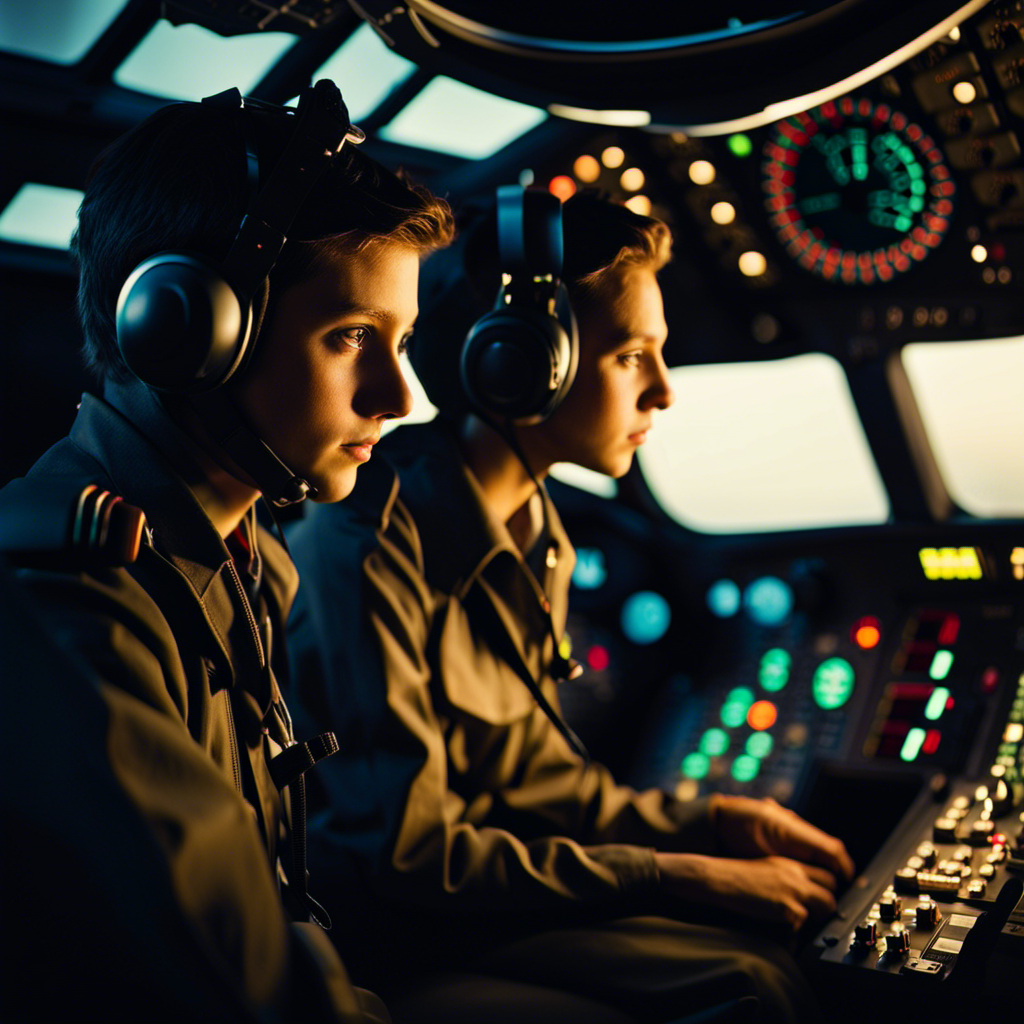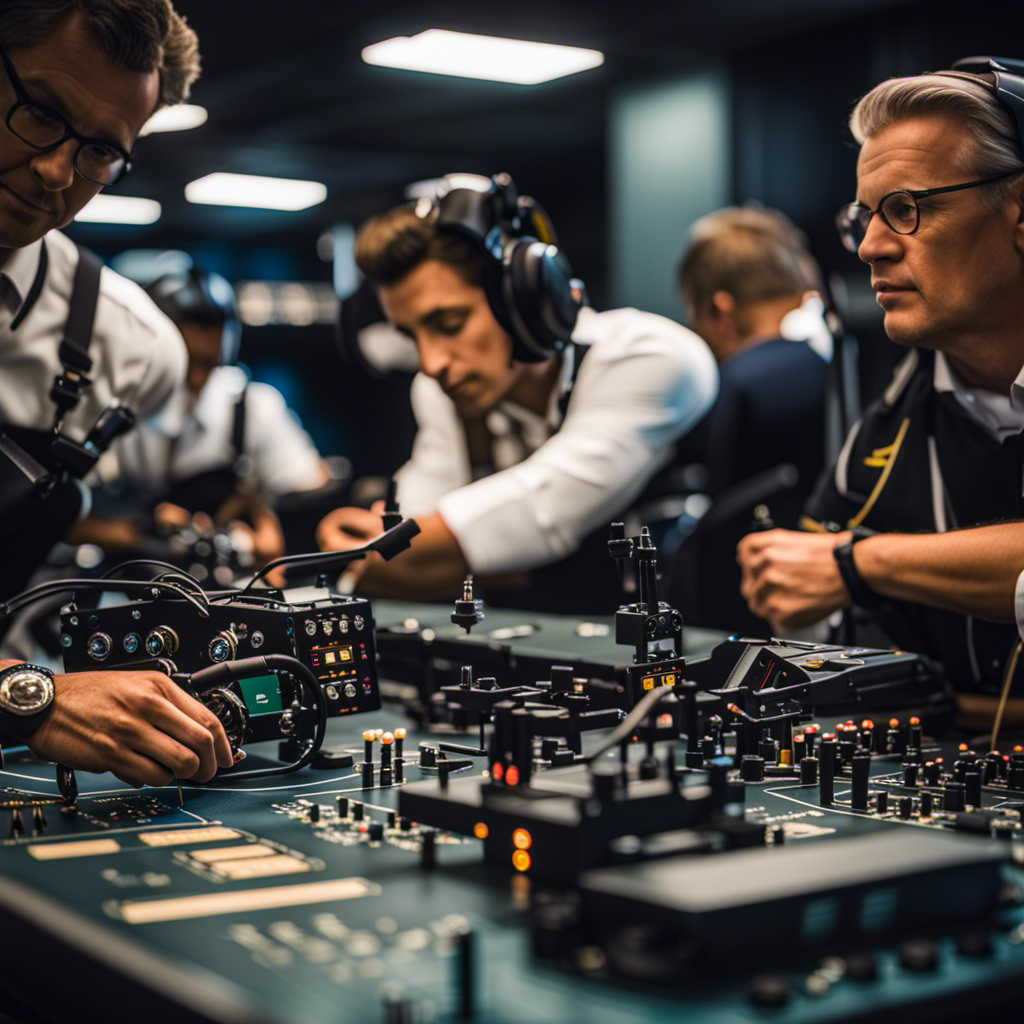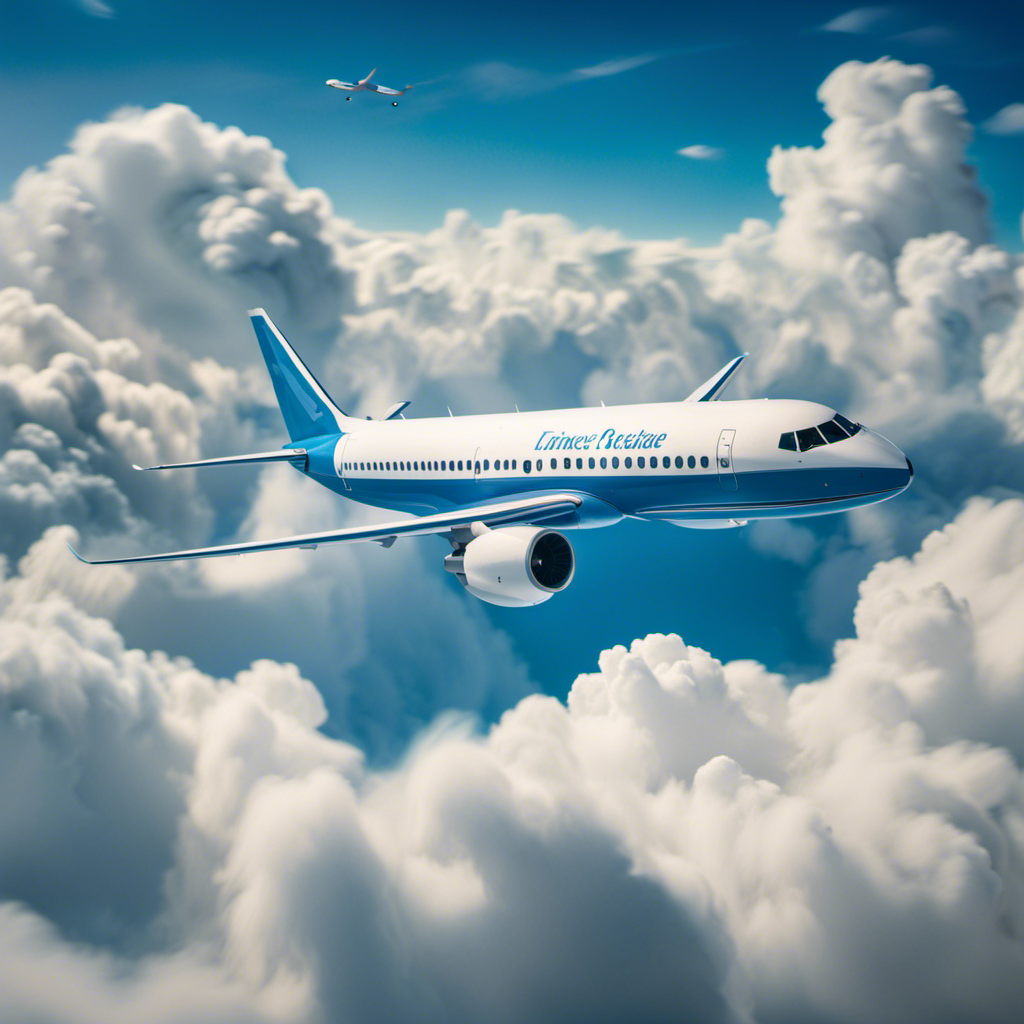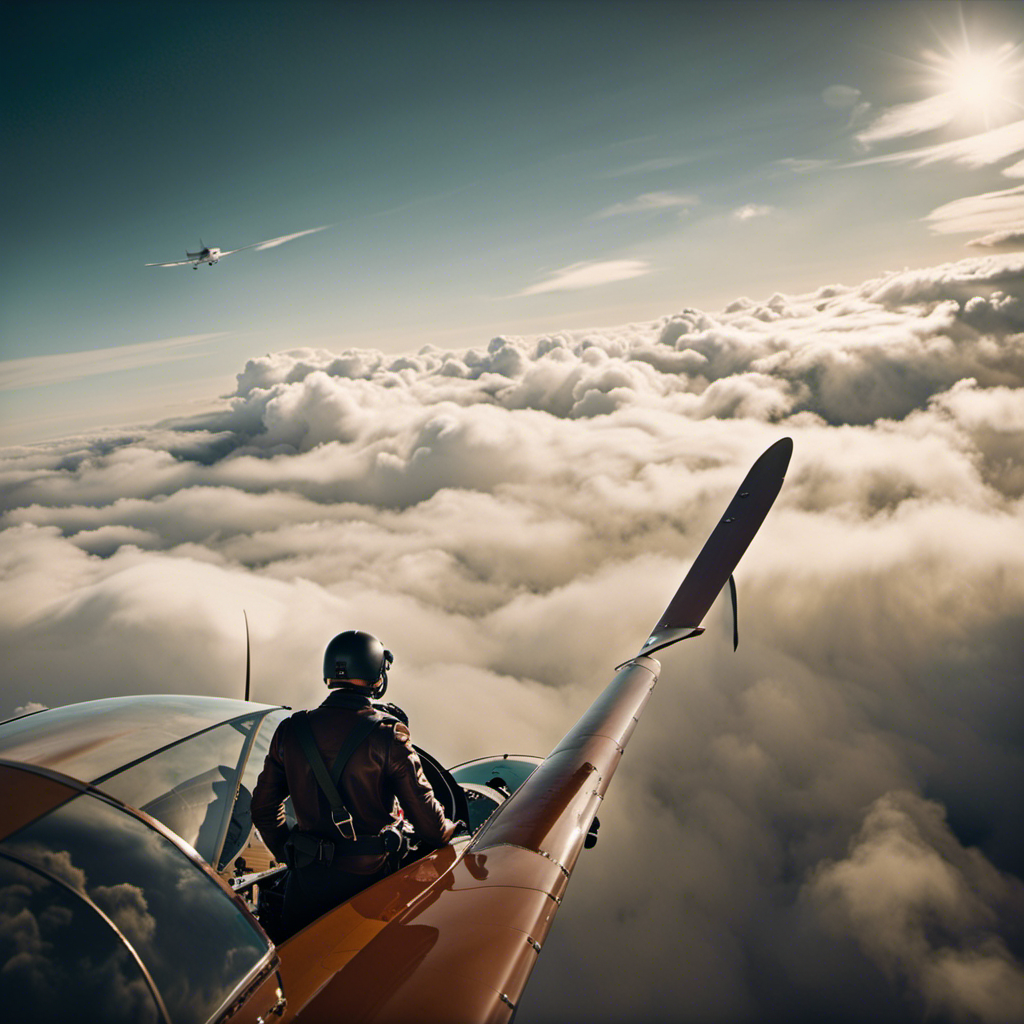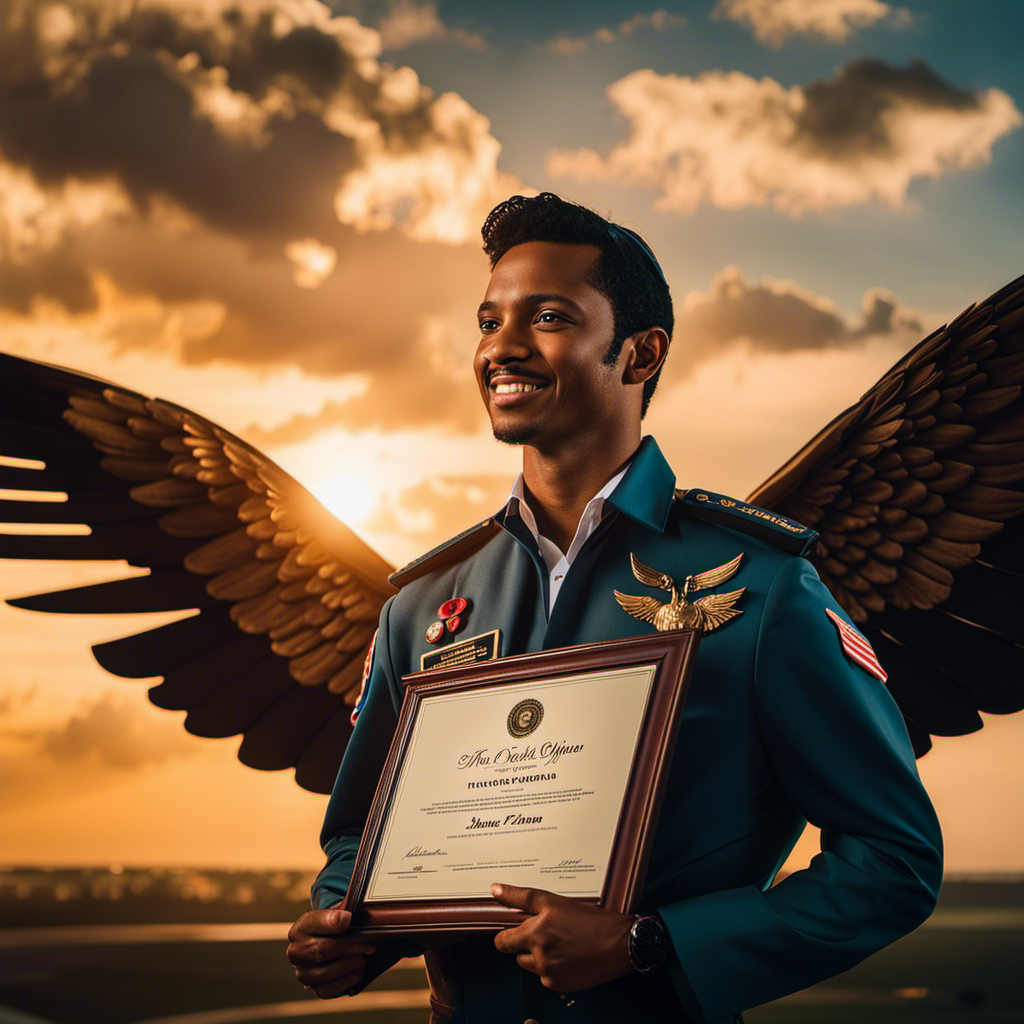The idea of flight has always fascinated me, but I never considered it as something I could pursue later in life. That changed when I met John, a retired teacher who decided to take up flying lessons at the age of 65. His determination inspired me to challenge the belief that there are age limits in the aviation world.
In this article, we’ll explore the benefits of learning to fly at any age, how to overcome age-related challenges, and the success stories of older pilots.
It’s never too late to spread your wings and take to the skies.
Key Takeaways
- Learning to fly at any age can increase confidence and provide a sense of accomplishment.
- Age-related challenges in flight training can be overcome through addressing physical abilities, cognitive functions, and adaptability concerns.
- Success stories of older pilots demonstrate determination, personal growth, and the transformative power of flight training.
- Finding the right flight school and training program, setting realistic goals, and celebrating achievements can lead to a successful aviation journey regardless of age.
The Benefits of Learning to Fly at Any Age
Learning to fly at any age brings numerous benefits. Increased confidence and a sense of accomplishment are just two advantages. It is a myth that flying is only for the young and fearless. In fact, there are many benefits to late-in-life learning.
First and foremost, learning to fly challenges the notion that age limits our abilities. By debunking age-related myths, we open ourselves up to new possibilities and experiences.
Learning to fly later in life also provides a unique perspective and a renewed sense of purpose. It allows us to push our boundaries and discover untapped potential.
As we overcome age-related challenges in flight training, we gain valuable skills in problem-solving, adaptability, and resilience. These benefits extend beyond the cockpit, enriching our lives in countless ways.
Overcoming Age-Related Challenges in Flight Training
Despite the challenges that come with age, older individuals can still successfully train to become pilots. As someone who has been in the aviation industry for many years, I can attest to the fact that age should never be a deterrent when it comes to pursuing a dream of flying.
Overcoming age-related fears is a crucial step in this journey. Many older individuals worry about their physical abilities, cognitive functions, and adaptability to new technologies. However, with the right mindset and commitment, these challenges can be overcome.
It is important to debunk the stereotypes that suggest older individuals are not capable of learning to fly. In reality, they bring a wealth of life experience, discipline, and dedication to the training process. These qualities often result in successful and inspiring stories of older pilots, which I will share in the next section.
Success Stories of Older Pilots
Many older individuals have successfully trained to become pilots, proving that age is not a deterrent in pursuing the dream of flying. These older pilot achievements not only demonstrate their determination and passion for aviation, but also highlight the impact of this pursuit on personal growth.
As an older pilot myself, I have witnessed firsthand the transformative power of flight training. Learning to fly at an older age has allowed me to challenge myself, push my limits, and expand my horizons. It has boosted my confidence, sharpened my decision-making skills, and instilled a strong sense of discipline. The journey to becoming a pilot has not only fulfilled my lifelong dream, but has also enriched my life in countless ways.
Now, let’s discuss the importance of finding the right flight school and training program, which is crucial for a successful aviation journey.
Finding the Right Flight School and Training Program
Finding the right flight school and training program is essential for aspiring pilots. As someone who has been through the process, I understand the importance of making the right choices.
One crucial aspect is choosing the right instructor. Look for someone with experience, expertise, and a teaching style that matches your learning needs. A good instructor can make all the difference in your training journey.
Another consideration is financing flight training. It’s no secret that flight training can be expensive, so it’s important to explore different financing options, such as loans, scholarships, or payment plans offered by flight schools.
By carefully selecting a flight school and instructor and exploring financing options, you can set yourself up for success in your pilot training.
Now, let’s delve into setting realistic goals and milestones without delay.
Setting Realistic Goals and Milestones
When it comes to flight training, I believe that creating a personalized plan is crucial for success. By tailoring the training to your individual needs and goals, you can ensure that you are making the most efficient use of your time and resources.
Breaking down the learning process into manageable steps allows for a more methodical and organized approach, helping to build a solid foundation of knowledge and skills.
And finally, celebrating achievements and progress along the way not only boosts motivation and confidence but also serves as a reminder of how far you’ve come on your journey to becoming a pilot.
Creating a Personalized Flight Training Plan
It’s important to create a personalized flight training plan that suits your individual needs and goals. As a flight instructor with years of experience, I have found that personalized flight training techniques are key to success in learning to fly.
Here are four ways to adapt your training to your individual learning style:
-
Visual Learners: Utilize diagrams, charts, and videos to enhance your understanding of concepts and procedures.
-
Auditory Learners: Take advantage of audio recordings and discussions with your instructor to reinforce your learning.
-
Kinesthetic Learners: Engage in hands-on activities and simulations to enhance muscle memory and procedural skills.
-
Tactile Learners: Use physical objects and manipulatives to reinforce your understanding of aircraft systems and controls.
By tailoring your training to your unique learning style, you can optimize your learning experience and progress more efficiently.
Now, let’s transition into breaking down the learning process into manageable steps.
Breaking Down the Learning Process into Manageable Steps
Breaking down the learning process into manageable steps allows for a more organized and systematic approach to flight training. When embarking on the journey to become a pilot, it is essential to set realistic goals and tackle them one by one.
By breaking down the learning process, you can avoid feeling overwhelmed and stay focused on each step. This approach allows you to fully grasp the necessary skills and knowledge at your own pace, building a solid foundation for your future as a pilot.
Setting realistic goals ensures that you are constantly making progress, which in turn boosts your confidence and motivation. Celebrating achievements and progress along the way further reinforces your commitment and passion for flying, making each milestone even more rewarding.
Transitioning into the subsequent section of celebrating achievements and progress, it is important to acknowledge that every step forward brings you closer to your ultimate goal of becoming a pilot.
Celebrating Achievements and Progress Along the Way
Celebrating achievements and progress along the way is an important aspect of staying motivated during flight training. As a pilot, I know firsthand the dedication and hard work required to earn your wings.
It can be easy to get caught up in the challenges and setbacks, but it’s crucial to take a step back and recognize how far you’ve come. Celebrating milestones, whether it’s completing a solo flight or mastering a difficult maneuver, gives you a sense of accomplishment and boosts your confidence.
It reminds you of the progress you’ve made and fuels your motivation to keep pushing forward. By celebrating these achievements, you create a positive mindset that propels you towards your ultimate goal of becoming a licensed pilot.
Maintaining a Positive Mindset and Motivation
Stay motivated and maintain a positive mindset as you pursue your dreams of learning to fly. Learning to fly can be an incredible journey filled with excitement and challenges. It’s important to stay motivated and focused, especially when faced with setbacks along the way.
To help you stay on track, here are some tips for maintaining motivation and dealing with setbacks:
| Maintaining Motivation | Dealing with Setbacks |
|---|---|
| Set clear goals and remind yourself why you started this journey. | Accept that setbacks are a natural part of the learning process. |
| Surround yourself with a supportive community of fellow aviators. | Learn from your mistakes and use them as opportunities for growth. |
| Celebrate small victories and milestones along the way. | Stay positive and maintain a can-do attitude. |
| Take breaks when needed to avoid burnout. | Seek guidance and support from experienced pilots or instructors. |
Navigating the Certification Process and Licensing Requirements
Understanding the different pilot certificates and ratings is essential for anyone considering a career in aviation. From private pilot to airline transport pilot, each certificate comes with its own set of privileges and requirements.
Meeting the medical requirements for flight is another crucial aspect of becoming a pilot, as a valid medical certificate is necessary to exercise the privileges of a pilot certificate.
Lastly, completing the required flight hours and examinations is a rigorous process that tests a pilot’s knowledge, skills, and ability to safely operate an aircraft.
Understanding the Different Pilot Certificates and Ratings
Pilot certificates and ratings can vary greatly, and it’s important to understand the differences. As someone aspiring to become a pilot, it’s crucial to grasp the various options available and how they can impact your pilot career opportunities and financial considerations. To help you navigate this complex landscape, let’s explore the different pilot certificates and ratings in detail:
| Certificate | Description |
|---|---|
| Student Pilot Certificate | The initial step in flight training, allowing you to fly under the supervision of a certified flight instructor. |
| Private Pilot Certificate | The most common certificate, enabling you to fly for personal reasons and carry passengers. |
| Commercial Pilot Certificate | Opens up opportunities for paid flying, such as becoming a flight instructor or working for an airline. |
| Airline Transport Pilot Certificate | The highest level of pilot certification, required for flying for a commercial airline. |
Understanding these varying certificates and ratings is essential for making informed decisions about your pilot career. However, it’s also crucial to meet the medical requirements for flight, ensuring your physical fitness to fly without explicitly mentioning the next section.
Meeting the Medical Requirements for Flight
Meeting the medical requirements for flight is crucial to ensure that you are physically fit to fly. As a pilot, I understand the importance of adhering to FAA regulations and managing medical conditions while flying. Here are some key points to keep in mind:
- Regularly visit an aviation medical examiner (AME) to obtain a medical certificate.
- Familiarize yourself with the FAA’s Guide for Aviation Medical Examiners.
- Be aware of any medications or treatments that may affect your ability to fly.
- Communicate openly with your AME about any medical conditions or concerns.
- Stay informed about updates and changes to medical certification requirements.
By following these guidelines, you can ensure that you are meeting the necessary medical standards for flying.
With your health in check, you can now focus on completing the required flight hours and examinations, taking you one step closer to achieving your pilot dreams.
Completing the Required Flight Hours and Examinations
Transition: Now that I have met the medical requirements, it’s time to focus on completing the required flight hours and examinations.
Current Subtopic: Completing the Required Flight Hours and Examinations
As a senior pilot, I understand the importance of efficiently overcoming time constraints and managing financial considerations. With a busy schedule and limited resources, I need to plan my flight hours and examinations strategically. I have found that setting aside dedicated time for flying and studying helps me stay on track and make progress.
Additionally, I have explored options for cost-effective flight training programs and sought out scholarships or financial aid opportunities. By being proactive and resourceful, I can ensure that I am making the most of my time and finances while working towards my goal of becoming a certified pilot.
Transition: Now that I have completed the required flight hours and examinations, the next step is to focus on staying safe and continuing to learn as a senior pilot.
Staying Safe and Continuing to Learn as a Senior Pilot
As a senior pilot, you can ensure your safety and continue learning by staying updated on aviation regulations and advancements. Here are three key ways to achieve this:
-
Staying fit: Taking care of your physical health is crucial in maintaining your proficiency as a pilot. Engaging in regular exercise and maintaining a balanced diet will help you stay alert and agile in the cockpit.
-
Managing time: As an experienced pilot, time management becomes even more important. Planning your flights meticulously, considering weather conditions and potential delays, will allow you to maintain punctuality and avoid rushing. This will contribute to a safer and more enjoyable flying experience.
-
Embracing technology: The aviation industry is constantly evolving, with new advancements and innovations being introduced regularly. By staying up-to-date with the latest technological developments, such as navigation systems and cockpit instruments, you can enhance your skills and adapt to the changing landscape of aviation.
The Joys and Rewards of Flying at Any Age
Transition: Now that we have discussed the importance of staying safe and continuing to learn as a senior pilot, let’s explore the joys and rewards that come with flying at any age. As a seasoned aviator, I can attest to the fact that flying brings immense joy and fulfillment, regardless of your age. It is a truly transformative experience that can have a profound impact on your mental health and overall well-being. The excitement of taking to the skies, the sense of freedom and adventure, and the thrill of mastering new skills all contribute to a heightened sense of happiness and satisfaction. Moreover, the journey of learning to fly, especially later in life, requires perseverance and determination, which in turn strengthens your resilience and mental fortitude. Let’s delve deeper into the importance of perseverance and the positive impact aviation can have on mental health.
| The Importance of Perseverance | The Impact of Aviation on Mental Health | Joys and Rewards of Flying |
|---|---|---|
| – Never giving up, even when faced with challenges and setbacks. | – Reducing stress and anxiety levels through the therapeutic effects of flying. | – The freedom of being able to explore new places from a unique perspective. |
| – Pushing oneself to overcome limitations and achieve personal goals. | – Boosting self-esteem and confidence through the mastery of new skills. | – The exhilaration of taking control of an aircraft and navigating through the skies. |
| – Embracing the learning process and continuously seeking improvement. | – Providing a sense of purpose and fulfillment through the pursuit of aviation. | – The camaraderie and sense of community among fellow aviators. |
| – Inspiring others through one’s perseverance and dedication to flying. | – Enhancing cognitive abilities and mental sharpness through aviation activities. | – The opportunity to challenge oneself and grow both personally and professionally. |
| – Leaving a lasting legacy in the aviation community and inspiring future generations. | – Fostering a positive mindset and promoting overall well-being. | – The satisfaction of accomplishing milestones and achieving lifelong dreams. |
As we have seen, the importance of perseverance and the impact of aviation on mental health cannot be overstated. The rewards of flying at any age are immeasurable, from the freedom and adventure it brings, to the sense of accomplishment and personal growth. However, flying is not just about personal fulfillment; it also has the power to inspire others and leave a legacy in the aviation world. Let’s explore how we can inspire others and make a lasting impact in aviation.
Inspiring Others and Leaving a Legacy in Aviation
Flying has the power to inspire others and create a lasting legacy in the aviation community. As a pilot, I have witnessed firsthand the impact that my passion for flying has on those around me. Here are three reasons why aviation can inspire others and leave a lasting legacy:
-
Breaking Barriers: When people see someone pursuing their dreams of flying, regardless of age or background, it inspires them to break free from their own limitations and pursue their passions.
-
Mentorship: As pilots, we have the opportunity to mentor aspiring aviators, passing on our knowledge and experiences. By sharing our stories and providing guidance, we can inspire others to take to the skies.
-
Community Impact: Aviation has the power to bring people together. By participating in aviation events, volunteering, or supporting aviation-related causes, we can leave a positive impact on our community, inspiring others to do the same.
Through inspiring others and leaving a legacy, we can ensure that the aviation community continues to thrive and grow for generations to come.
Frequently Asked Questions
What are the physical requirements for learning to fly at an older age?
Physical limitations for learning to fly at an older age vary, but generally include good overall health, adequate vision and hearing, and the ability to handle the physical demands of operating aircraft controls. However, the benefits of learning to fly at an older age outweigh these limitations.
How long does it typically take to obtain a pilot’s license as an older adult?
Obtaining a pilot’s license as an older adult can take an average of 6-12 months. The challenges may include physical fitness, learning new technology, and adapting to new regulations.
Are there any age-related limitations on the types of aircraft older pilots can fly?
Age restrictions on commercial flying exist to ensure safety. However, pilot career opportunities are abundant regardless of age. Older pilots can fly a variety of aircraft, as long as they meet the required medical standards.
Are there any special considerations for older pilots when it comes to aviation medical exams?
As an experienced pilot, I can tell you that older pilots do have special considerations when it comes to aviation medical exams. These exams are important to address potential health issues that may affect their ability to fly safely.
What resources are available to older adults who want to pursue a career in aviation?
As an experienced pilot, I know that pursuing a career in aviation as an older adult can be daunting. However, there are resources and support networks available to help you navigate this journey and achieve your dreams.
Conclusion
In conclusion, it’s never too late to pursue your dreams of flying. Age should never be a barrier when it comes to learning and experiencing the joys of aviation. As the saying goes, "age is just a number," and this holds true in the world of flying.
Just like the inspiring stories of Amelia Earhart and Chuck Yeager, who defied limits and soared to new heights, you too can defy the age limit myth and leave a lasting legacy in aviation.
So, don’t let your age hold you back. Take to the skies and let your dreams take flight.
With a heart that soars as high as the skies, Aria, affectionately known as “Skylark,” is the driving force behind Soaring Skyways. Her journey into the gliding world began as a young dreamer gazing up at the soaring birds, yearning to experience the weightlessness and freedom they embodied. With years of experience both in the cockpit and behind the scenes, Aria’s commitment to the gliding community is unwavering.

